 Mill Street Synagogue 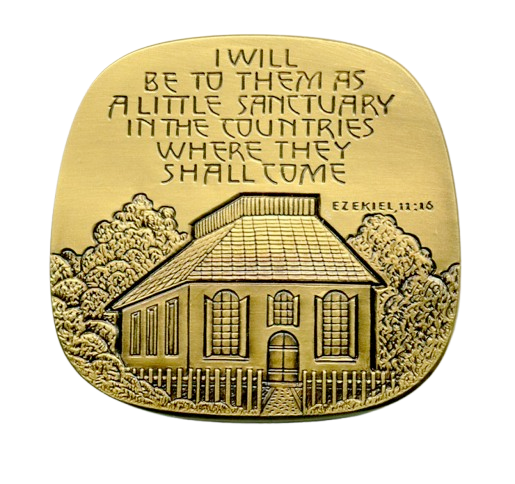 |
First Jewish Settlers in America medal designed by Alex Shagin. Mill Street Synagogue,
I WILL BE TO THEM AS A LITTLE SANCTUARY IN THE COUNTRIES
WHERE THEY SHALL COME/EZEKIAL 12:16. 49 x 47 mm. Issued in 1999.
In 1654, the first Jews arrived in New Amsterdam. After being initially rebuffed by Peter Stuyvesant, they were given official permission to settle in the colony in 1655. This year marks the founding of the Congregation Shearith Israel. The Jews were not given permission to worship in a public synagogue until 1730 that the Congregation was able to build a synagogue of its own; it was built on Mill Street in lower Manhattan. The Congregation remained there until it moved uptown in 1834.
Gershom Mendes Seixas
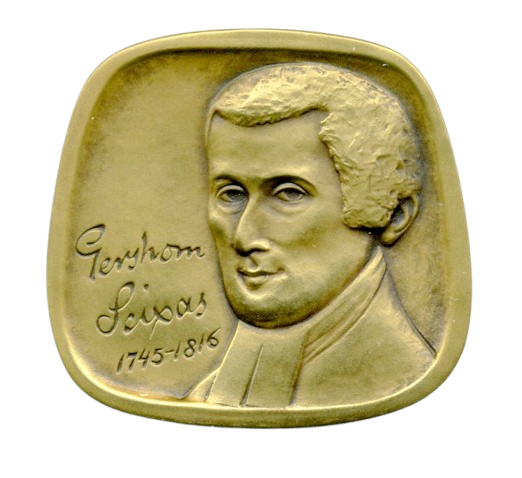 | 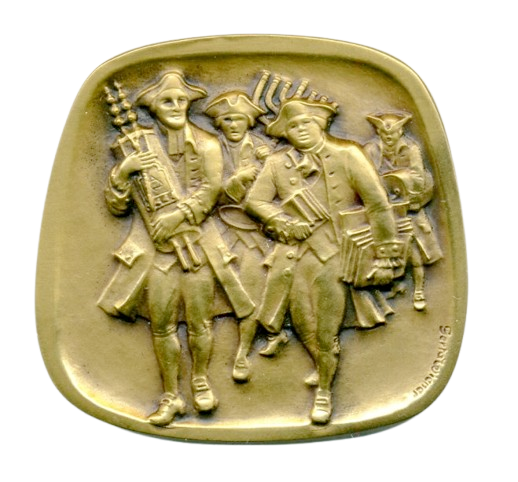 |
Gershom Mendes Seixas medal by Gerta Ries Wiener. Obverse: Gershom Seixas
1745-1816. Reverse: Seixas and congregants carrying Jewish ceremonial objects
from Mill Street Synagogue, Gerta Wiener. 47 x 45 mm. Issued in 1975.
In 1766, Gershom Mendes Seixas became the leader of Shearith Israel, and remained its minister for about a half century. Although not ordained as a rabbi, Seixas served as hazzan and religious leader to the congregation and was among the first leaders of the Jewish community who had been born and educated in the United States. As the British fleet approached New York Bay in August, 1776, Seixas preached an emotional sermon in English, warning that that day’s services might be the last held in the historic edifice. His Patriot loyalties provoked Shearith Israel to seal its entrance as the British approached, and Mendes Seixas left New York rather than remain under British rule. He rescued the scrolls of the Law and other ceremonial items as he fled for Stratford, Connecticut, where he remained until 1780. In 1781 he was invited to serve as chazan at the newly established Sephardi congregation, Mikveh Israel in Philadelphia, where many patriots had fled from New Amsterdam and elsewhere. Many important politicians attended the synagogue’s dedication, including the governor of Pennsylvania, and Seixas invoked “the blessings of Almighty God on the Members of these States in Congress assembled and on his Excellency George Washington, Commander-General of these Colonies”.
 |
The first Jewish American medal, designed by Moritz Fürst. With incused inscription:
“BORN JANUARY 14TH, 1745 GERSHOM MENDES SEIXAS DIED JULY 2ND, 1816.” Courtesy of Columbia University.
Touro Synagogue
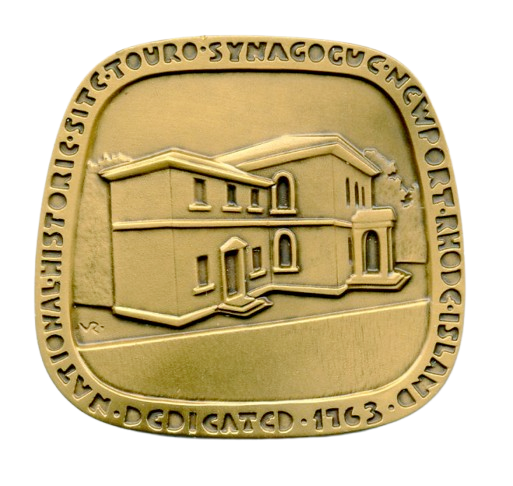 | 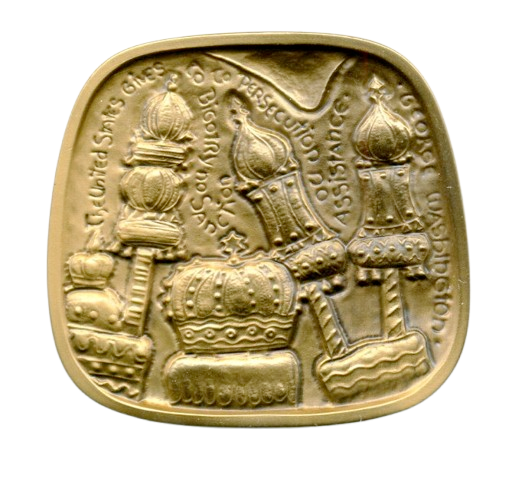 |
Touro Synagogue medal designed by Victor Ries. Obverse: NATIONAL ●
HISTORIC ● SITE ● TOURO ● SYNAGOGUE ● NEWPORT ● RHODE ● ISLAND ●
DEDICATED ● 1763, VR monogram. Reverse: Torah crowns and rimonim, created
by Myer Myers, The United States gives to bigotry no sanction, to persecution no
assistance ● George Washington. 47 x 45 mm. Issued in 1977.
At the time of the American Revolution, there were 30 Jewish families in Newport, and this was their golden age: they were successful businessmen and ship-owners. This group was dispersed by the war, and the original community never came back, though individuals did. The synagogue survived the war because it was used by the British as a hospital, not because it was a house of worship. Later, it was used as a courthouse. Among the treasures now on display is a 500-year-old Torah believed to have been brought here by the first Sephardic Jews, and Torah crowns designed by the American silversmith Myer Myers (pictured on the medal’s reverse), surrounded by an excerpt of George Washington’s famous letter to the Congregation.
On August 18, 1790, President George Washington visited Newport as part of a tour of New England following Rhode Island’s ratification of the Constitution. He met with various local religious groups including Christians, Freemasons, and the Touro Synagogue congregation, known as Congregation Yeshuat Israel at the time, and read open letters in a prearranged ceremony.[13] Touro Synagogue’s warden, Moses Seixas, wrote to Washington, expressing the support of the Congregation for Washington’s administration and good wishes for him.
Washington sent a letter on August 21 in response, which read in part:
… the Government of the United States … gives to bigotry no sanction, to persecution no assistance. … May the children of the Stock of Abraham, who dwell in this land, continue to merit and enjoy the good will of the other Inhabitants; while every one shall sit in safety under his own vine and fig tree, and there shall be none to make him afraid. May the father of all mercies scatter light and not darkness in our paths, and make us all in our several vocations useful here, and in his own due time and way everlastingly happy.

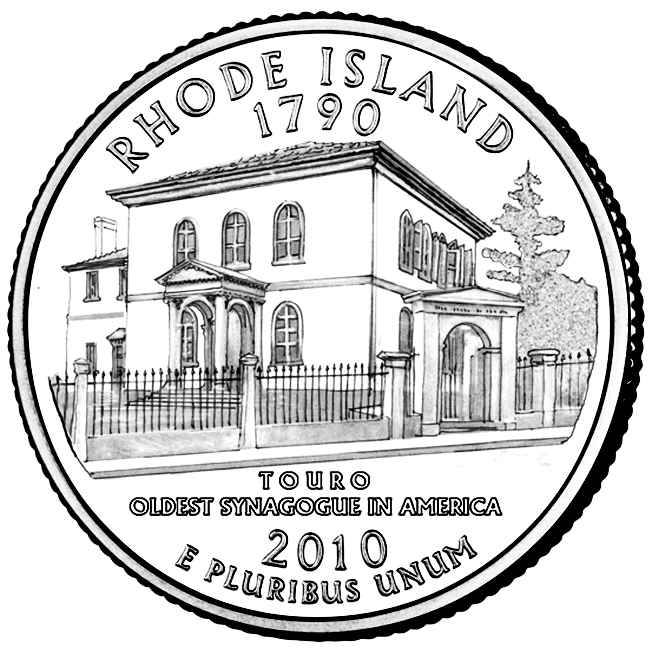
Proposed design for U.S. quarter commemorating Touro Synagogue, by Joel Iskowitz.
Haym Salomon
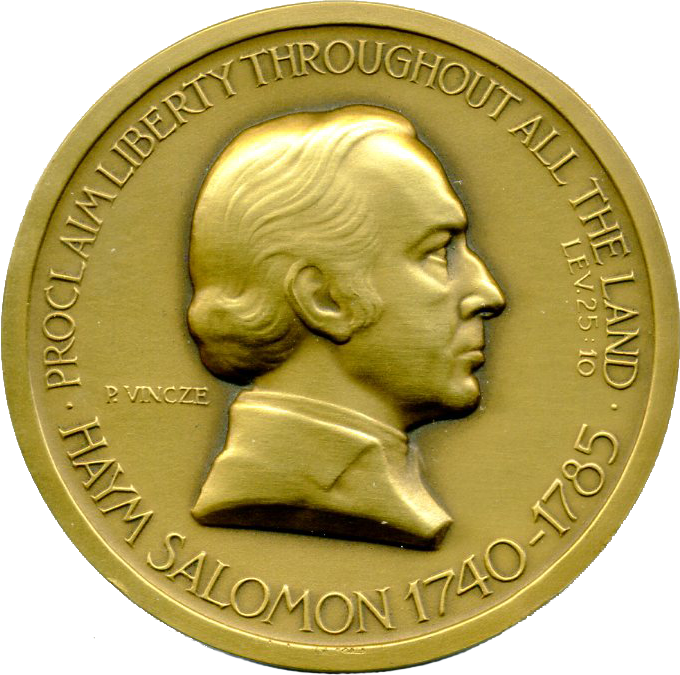 | 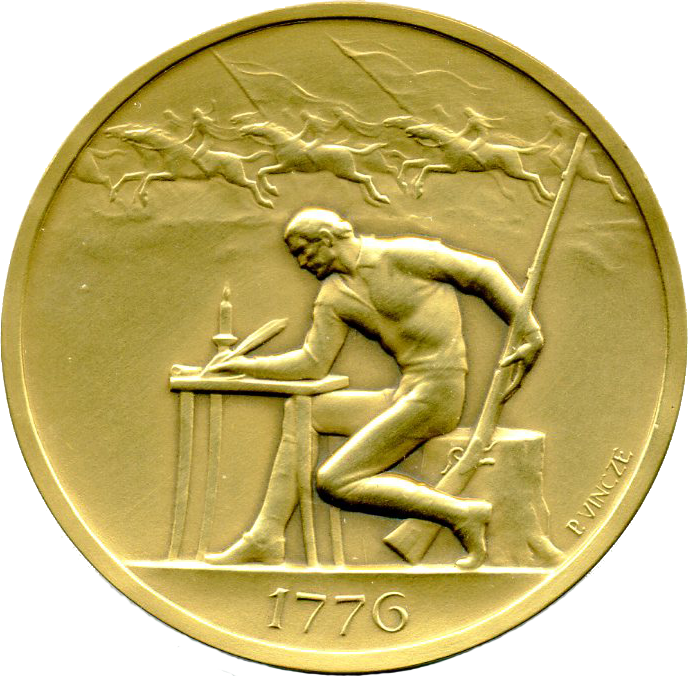 |
Haym Salomon medal designed by Paul Vincze. Obverse: Portrait, PROCLAIM LIBERTY
THROUGHOUT ALL THE LAND/LEV. 25:10/HAYM SALOMON 1740-1785/P. VINCZE. 58
mm. Issued to commemorate America’s Bicentennial, 1973.
Haym Salomon was born on April 7, 1740 in Leszno, Polish–Lithuanian Commonwealth to a Sephardic Jewish family descended from Spanish and Portuguese Jews who gradually migrated to Poland following the expulsion of Jews from Spain in 1492. During his adult travels in Western Europe, Salomon acquired a knowledge of finance and fluency in some of the languages of the day. He returned to Poland in 1770 but left for England two years later in the wake of the First Partition of Poland in 1772. In 1775, he immigrated to New York City, where he established himself as a financial broker for American merchants engaged in overseas trade.
Sympathizing with the Patriot cause, Salomon joined the New York branch of the Sons of Liberty. In September 1776, he was arrested by the British as a spy, but quickly pardoned. However, the British authorities detained him for 18 months on a boat as an interpreter for Hessian troops, since Salomon could speak German. Salomon used his new position to help prisoners of war from the Continental Army escape, encouraged Hessian troops to desert, and collaborated with Hercules Mulligan and Cato to carry out other acts of espionage. In 1778 Salomon was arrested again, convicted of espionage, and sentenced to death. He eventually escaped and made his way with his family to Philadelphia, where the Continental Congress was located.
During the period from 1781 to 1784, records show Salomon’s fundraising and personal lending helped provide over $650,000 ($14.8 million in 2024) in financing to General George Washington in his war effort. His most meaningful financial contribution, however, came immediately prior to the Siege of Yorktown. Washington determined that he needed at least $20,000 to finance the campaign. When Morris told him there were no funds and no credit available, Washington said: “Send for Haym Salomon”. Salomon raised $20,000, through the sale of bills of exchange. With that contribution, Washington conducted the Yorktown campaign, which proved to be the final battle of the Revolution.
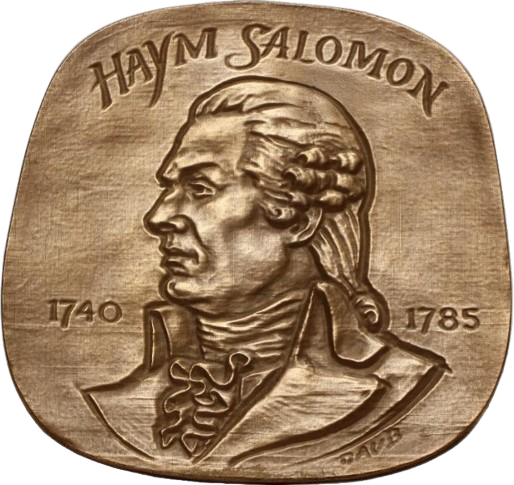 | 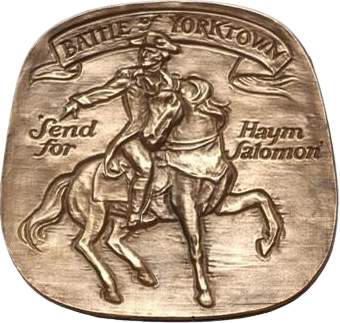 |
Haym Salomon medal designed by Eugene Daub, cast in quantity of 100 bronze
maximum. Obverse: Portrait, HAYM SALOMON, 1740 1885, DAUB. Reverse: George
Washington on horseback, BATTLE OF YORKTOWN, “Send for Haym Salomon”, DAUB.
88 mm. Issued to commemorate America’s Semiquincentennial, 2026.
The financier died suddenly and in poverty on January 6, 1785, in Philadelphia. Due to the failure of governments and private lenders to repay the debt incurred by the war, his family was left penniless at his death at age 44. The hundreds of thousands of dollars of Continental debt Salomon bought with his own fortune were worth only about 10 cents on the dollar when he died.
His obituary in the Independent Gazetteer read, “Thursday, last, expired, after a lingering illness, Mr. Haym Salomon, an eminent broker of this city, was a native of Poland, and of the Hebrew nation. He was remarkable for his skill and integrity in his profession, and for his generous and humane deportment. His remains were yesterday deposited in the burial ground of the synagogue of this city.”